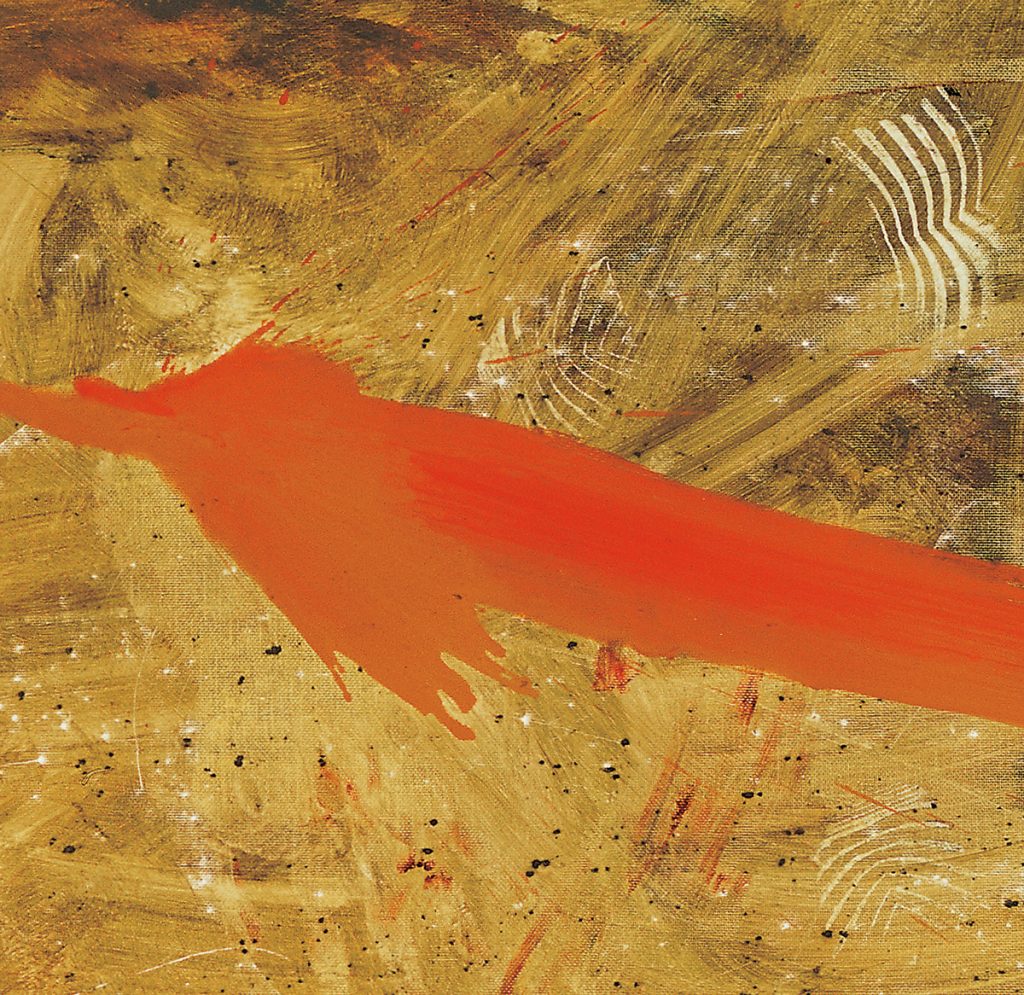When we walk into a good antique shop we appreciate the craftsmanship of the pieces. We see the time and skill put into the glass, silver, and wood. Antiques have a quality of richness because in the past artisans had more time to put into their craft—things were not mass-produced, and there was a sense of lineage, a way of doing things. The energy put into the creation of art reflects our own richness and communicates this richness to others. Our appreciation of a beautiful piece of art is not limited to the piece itself—we experience the process that the artist went through as well; it is a transference of consciousness. Whether we are an artist or an onlooker, we feel the creative energy. When it has been formalized into a piece, the artist’s energy has not become the piece itself, but the piece is blessed by the creativity of the artist.
We usually think of creativity as “belonging” to the artist. But in a larger sense, creative energy is innate and spontaneously present. It is unborn, with no center or boundary, yet nothing exists outside of it. The mountains and oceans, the sun and moon, even the seasons arise spontaneously from it. What has become “our life,” everything we are and everything we have been since we stepped into this world, is spontaneously present. Our genetic makeup—the egg and sperm of our parents—arose from and is encompassed by the creative energy of our basic nature. The great Buddhist practitioner Kunchyen Longchenpa said: “The universe is spontaneously present, who could have created it? It is the grand production of its creative energy.” And all appearance is blessed by it.
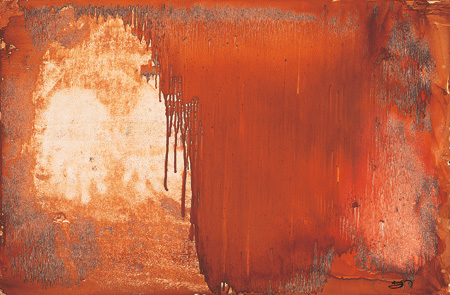
When we speak about natural creativity and its expression, we are not talking about something separate from our own mind and experience. All that we call “existent phenomena” is experienced by mind. This awareness is primordial and omnipresent—is there ever a time when we don’t experience? Experience can be dull, we may be asleep, we may be ignorant or distracted, but we are always “awake” in one way or another—experiencing our thoughts, our emotions, our state of mind, experiencing our dullness, our distractedness or joy. There has never been a time when we have been inanimate, like a rock. This creative energy never leaves us, whether we turn toward ignorance or enlightenment; whether our intelligence is obstructed or not; whether we operate from the ego or from a bigger state of mind. It remains in its own naked state at all times.
Even if we aspire to enlightenment, if we don’t appreciate and trust the potential and expression of our natural creativity—which is all phenomena—and we look for enlightenment elsewhere, our spiritual path will become dualistic. It is an egoistic tendency to try to arrange phenomena according to our preferences rather than appreciate them for what they are. This approach leads us to resent certain experiences and search for an enlightenment—or a creativity—divorced from what we directly encounter. Resenting experience is resenting the natural vitality of mind and prevents us from having a trust in the fullness of the way phenomena unfold. So we need to see this primordial potential in all of our experiences in the same way a doctor sees the health and well-being in his patients. If a patient didn’t possess a fundamental well-being, what would be the point of prescribing such antidotes as medicines, exercise, or new diets?
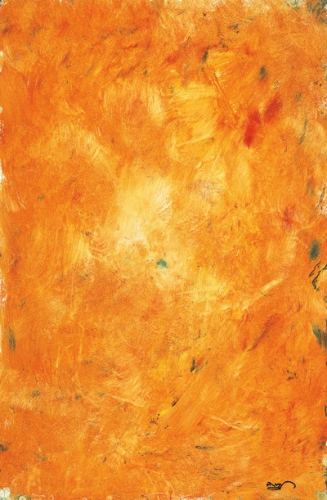
In truth, enlightenment is always grounded in our own direct experience of mind and its activities, no matter what they may be. When we trust our creative energy, we encounter a supreme kind of enjoyment—an amazement at the natural unfolding of life beyond our ordinary way of looking at things. When we talk about creating art—or more importantly, the art of living a sane life—it means trusting our basic nature and its natural creativity. Natural creativity is something very large, the essence of everything. As artists we make such a big deal about creating something “good,” something “pleasing.” We want everyone to love our creations in order to confirm our existence. Our insecurities, hopes, and fears haunt us. Either we feel we lack the ability to create or we use art as a means to solidify ourselves: “Look here, my art is in the Guggenheim!” “Look at my résumé, I danced with the Russian Ballet!” Don’t let your insecurities rob you of your trust! Just remember, this natural energy created the entire universe—a humbling thought that puts our own artistic creations in perspective! Think: “The universe is here! Where did it come from?” Then have some trust and let this natural energy express itself.
Related: The Yoga of Creativity
Abstract art expresses itself without structure, theme, rules, concepts, or guidelines. We gather together the elements such as the paint, canvas, and turpentine, and with a minimal amount of technique we just “let it happen.” This is the kind of work I do. My painting teacher, Yauhne de Tamlin, studied traditional art much of her life and later started to experiment and let go of those forms. I became interested in working with this formless practice because I felt it would enhance and compliment my meditation and free up my creative expression. I didn’t engage traditional art but dove right in with my teacher and what she was doing.
As with art, in meditation practice we begin with techniques or reference points that help us engage the mind in a sane way. But as we come to know the mind, we begin to see mind and its activities like we see the ocean and its waves. The activity of water often manifests as ripples and sometimes as enormous waves, yet essentially this movement is always made of water. We cannot say the waves and the water are one thing, yet we also cannot say they are separate. It is the same when we speak about mind and its activities. In meditation practice we see that all movement of mind is the manifestation of the primordial creative energy. So whatever arises in the mind we understand to be blessed by this energy. Like water and waves, mind and activities share this relationship of essence and expression.
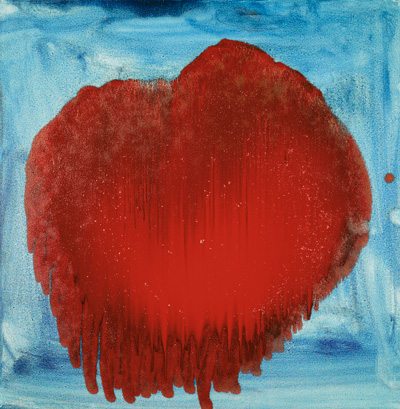
My instruction from Yauhne reflects a discipline that integrates this view of meditation and art. She would say, “When you get attached to anything that emerges on the canvas, destroy it!” I would watch her create something beautiful and then paint over it or scrape off the paint. “Destroy, destroy, destroy.” This is not to say that beauty or attachment to beauty is a problem. Destroying them is not an aggressive act, an annihilation of self or a rejection of experience. It enhances creativity. It is a natural wearing away of attachment and becomes a part of the creative process itself—a way to engage a bigger mind. The more I do this, the greater the satisfaction. I am not fixated on creating something “good” or “pleasing.” My interest or focus is on the process of creating and connecting to my natural creativity. The main discipline is to let go.
Usually I go through the process of destroying many times in order to get beyond my insecurities, hopes, and fears. Often the paintings I destroy repeatedly are the least contrived, raw, and most provocative. They are often unrecognizable from one moment to the next—even the colors change. Because we paint with oil and turpentine, the paint is easy to manipulate. The combination provides a freedom of expression, because one can easily add, remove, or scrape away any paint. Recently I heard an artist talk about her experience of creating a painting. She had a big red shape in the middle of the painting that she got attached to. She wanted to keep it in. Somehow she found she couldn’t move freely with her creativity because she was painting around it and this restricted her creative movement. Finally she decided to let it go. Only then could she move ahead and be surprised at what would finally emerge.
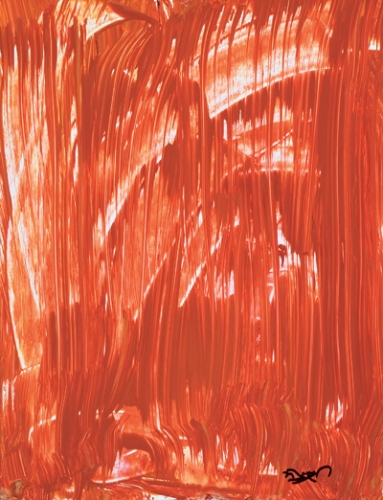
When I have exhausted my fixations through the process of destroying, I let the painting be. At this point I have reached what I call the “mark of non-creating”—a state of uncontrived creativity where the artist just steps out of his or her own way. When I find that I have arrived at that point I just drop any activity—stop—and leave the painting right there without trying to improve or manipulate it. I never judge my paintings—I always appreciate and spend time with them because I appreciate where they come from. It is similar to appreciating and coming to understand all aspects of my mind through the process of meditation: whatever arises teaches me something. Everything I encounter is fresh and surprising. In this way I never become stagnant in my work. Sometimes I access this freedom more quickly than at others, but I trust that it is always present as the nature of all expression. This is an invigorating and deeply fulfilling liberation. I feel in awe of the whole process, which is simply an expression of my own and others’ creative energy. When it comes to art, the process we engage in is reflected in its expression. If we trust in the basic nature—it is communicated. If art is contrived and self-focused—it is communicated. Ultimately, because everything arises from the creative nature of primordial mind, there is nothing that is more profound, miraculous, or “creative” than anything else. My hope is that my paintings communicate the beauty of this unhindered practice of free expression.
All images: © Kontrul Jigme Namgyel
Thank you for subscribing to Tricycle! As a nonprofit, we depend on readers like you to keep Buddhist teachings and practices widely available.
